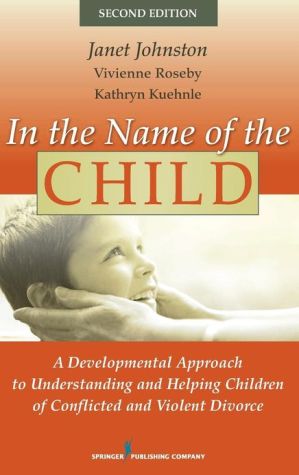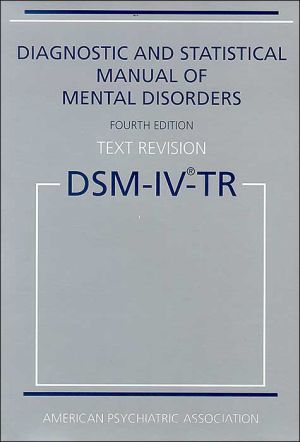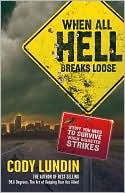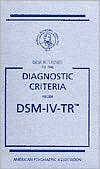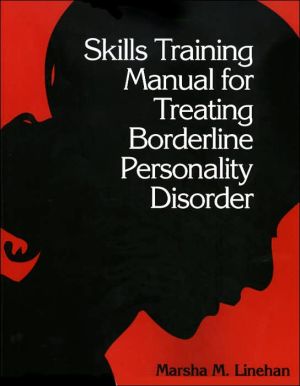In the Name of the Child: A Developmental Approach to Understanding and Helping Children of Conflicted and Violent Divorce
"Johnston, Roseby, and Kuehnle take you behind the child's eyes, into their heads...[they] flesh out the familial context, and bring it all back into the larger social world....When you are done reading, you know who these families are, what the children need, and -- as a clinician -- how you can help them."--Marsha Kline Pruett, PhD, MSL Maconda Brown O'Connor ProfessorSmith College School for Social Work"This book addresses problems that arise for children of conflicted and violent...
Search in google:
"Johnston, Roseby, and Kuehnle take you behind the child's eyes, into their heads...[they] flesh out the familial context, and bring it all back into the larger social world....When you are done reading, you know who these families are, what the children need, and -- as a clinician -- how you can help them."--Marsha Kline Pruett, PhD, MSL Maconda Brown O'Connor ProfessorSmith College School for Social Work"This book addresses problems that arise for children of conflicted and violent divorce .It provides a good base for beginning to treat children in this situation as well as good information for understanding the legal and community services available."--Doody'sThe fully updated and revised edition of In the Name of the Child examines both the immediate and long-term effects of high-conflict divorce on children. By combining three decades of research with clinical experience, the authors trace the developmental problems affecting very young children through adolescence and adulthood, paying special attention to the impact of family violence and the dynamics of parental alienation. The authors present clinical interventions that have proven to be most effective in their own clinical work with families. With a new emphasis on the need for prevention and early intervention, this edition examines how defensive strategies and symptoms of distress in children can consolidate into immutable, long-standing psychopathology in their adult lives. This book contains the policies and procedures that can preempt these high-conflict outcomes in divorcing families.Key Features:Contains a new chapter examining the effects of violent divorce on a sample of young adults, tracking their developmental changes from adolescence through adulthood Discusses the developmental threats to both boys and girls of different ages and stages, along with therapeutic interventions and guidelines for parenting plansProposes principles and criteria for decision-making about custody, visitation, and parenting plans based on individual assessment of the developing child within his or her familyMental health professionals, educators, family lawyers, judges, and court administrators will find this book to be an essential read, with all the knowledge and insight needed to understand the short- and long-term effects of violent divorce on children. Doody Review Services Reviewer:Jada Johnson, MD(Rush University Medical Center)Description:This book addresses problems that arise for children of conflicted and violent divorce. It suggests a multidisciplinary intervention approach to limiting the negative psychological impact these divorces can have on children.Purpose:The purpose is to understand a child's experience of conflicted and violent divorce and how it may lead to psychopathology and to emphasize the importance of early intervention to limit the extent of the psychopathology. On some level these objectives are met, but there is a considerable amount of time dedicated to the intrapsychic workings of the parents.Audience:According to the authors, this book is written for a multidisciplinary audience of family law professionals (judges, family lawyers, mediators, child custody evaluators) and mental health practitioners. However, it appears geared primarily to mental health workers who would understand the complex psychodynamic formulations of behavior and pathology that it discusses. Although the book is an easy read, it requires a knowledge base in psychodynamic theory to fully understand. The author has 30 years of experience in working with this specialized group of children. Features:The book covers the psychological dynamics for the parents as well as the child who is in the middle of a conflicted/violent divorce. Explicitly it describes how children may manage the conflict by use of various defenses based on their corresponding developmental level. I appreciate how this book uses case examples to explore the complicated dynamic processes. The book also covers special issues that may arise (i.e. parental abduction, sexual abuse allegations). Useful appendixes provide guidelines for assessment of these families and research data about conflicted and violent divorce.Assessment:This is a very useful book, especially the elements aimed at understanding the psychodynamic processes of parents and children involved in a conflicted or violent divorce. It provides a good base for beginning to treat children in this situation as well as good information for understanding the legal and community services available. This comprehensive book has increased my awareness of the issues involved in this area.
chapter
Preface ixAcknowledgments xvPart I The Problem and the ChallengeChapter 1 The Family Crucible of High-Conflict and Violent Divorce 3Chapter 2 The Prism and Prison of the Child 29Part II The Development of Children and Youth in High-Conflict FamiliesChapter 3 Infants and Toddlers: Problems in Separation-Individuation 59Chapter 4 Preschoolers: Separation, Gender and Sexualized Anxiety 93Chapter 5 School-age Children: The Struggle to Feel Lovable, Good, and Competent 129Chapter 6 Adolescents: Toward Resolution or Stalemate 157Chapter 7 Young Adults: Struggling with the Legacy 193Part III Interventions on Behalf of Children in High-Conflict and Violent DivorceChapter 8 Building Multidisciplinary Partnerships Between the Family Court and the Community 225Chapter 9 Co-Parenting Counseling and Parent Coordination 255Chapter 10 Treatment of Children in Conflicted and Violent Families 279Part IV Special Issues in Difficult Custody-Disputing FamiliesChapter 11 Domestic Violence: Differential Assessment and Parenting Plans 307Chapter 12 Parental Abduction: Risk Factors and Preventive Interventions 335Chapter 13 Parental Alignments and Alienation: Differential Assessment and Therapeutic Interventions 361Chapter 14 Child Sexual Abuse Allegations in Custody Disputes 391Appendix 413Part A Guidelines for Initial Assessment 415Part B Summary of Empirical Studies 423Part C Publications of Research Findings 431References 435Index 459
\ Reviewer: Jada Johnson, MD(Rush University Medical Center)\ Description: This book addresses problems that arise for children of conflicted and violent divorce. It suggests a multidisciplinary intervention approach to limiting the negative psychological impact these divorces can have on children.\ Purpose: The purpose is to understand a child's experience of conflicted and violent divorce and how it may lead to psychopathology and to emphasize the importance of early intervention to limit the extent of the psychopathology. On some level these objectives are met, but there is a considerable amount of time dedicated to the intrapsychic workings of the parents.\ Audience: According to the authors, this book is written for a multidisciplinary audience of family law professionals (judges, family lawyers, mediators, child custody evaluators) and mental health practitioners. However, it appears geared primarily to mental health workers who would understand the complex psychodynamic formulations of behavior and pathology that it discusses. Although the book is an easy read, it requires a knowledge base in psychodynamic theory to fully understand. The author has 30 years of experience in working with this specialized group of children. \ Features: The book covers the psychological dynamics for the parents as well as the child who is in the middle of a conflicted/violent divorce. Explicitly it describes how children may manage the conflict by use of various defenses based on their corresponding developmental level. I appreciate how this book uses case examples to explore the complicated dynamic processes. The book also covers special issues that may arise (i.e. parental abduction, sexual abuse allegations). Useful appendixes provide guidelines for assessment of these families and research data about conflicted and violent divorce.\ Assessment: This is a very useful book, especially the elements aimed at understanding the psychodynamic processes of parents and children involved in a conflicted or violent divorce. It provides a good base for beginning to treat children in this situation as well as good information for understanding the legal and community services available. This comprehensive book has increased my awareness of the issues involved in this area.\ \ \ \ \ Reviewer:Jada Johnson, MD(Rush University Medical Center)\ Description:This book addresses problems that arise for children of conflicted and violent divorce. It suggests a multidisciplinary intervention approach to limiting the negative psychological impact these divorces can have on children.\ Purpose:The purpose is to understand a child's experience of conflicted and violent divorce and how it may lead to psychopathology and to emphasize the importance of early intervention to limit the extent of the psychopathology. On some level these objectives are met, but there is a considerable amount of time dedicated to the intrapsychic workings of the parents.\ Audience:According to the authors, this book is written for a multidisciplinary audience of family law professionals (judges, family lawyers, mediators, child custody evaluators) and mental health practitioners. However, it appears geared primarily to mental health workers who would understand the complex psychodynamic formulations of behavior and pathology that it discusses. Although the book is an easy read, it requires a knowledge base in psychodynamic theory to fully understand. The author has 30 years of experience in working with this specialized group of children. \ Features:The book covers the psychological dynamics for the parents as well as the child who is in the middle of a conflicted/violent divorce. Explicitly it describes how children may manage the conflict by use of various defenses based on their corresponding developmental level. I appreciate how this book uses case examples to explore the complicated dynamic processes. The book also covers special issues that may arise (i.e. parental abduction, sexual abuse allegations). Useful appendixes provide guidelines for assessment of these families and research data about conflicted and violent divorce.\ Assessment:This is a very useful book, especially the elements aimed at understanding the psychodynamic processes of parents and children involved in a conflicted or violent divorce. It provides a good base for beginning to treat children in this situation as well as good information for understanding the legal and community services available. This comprehensive book has increased my awareness of the issues involved in this area.\ \
